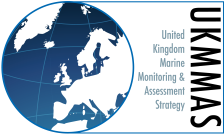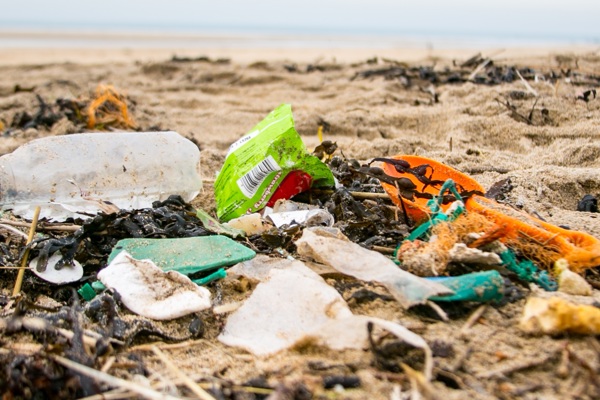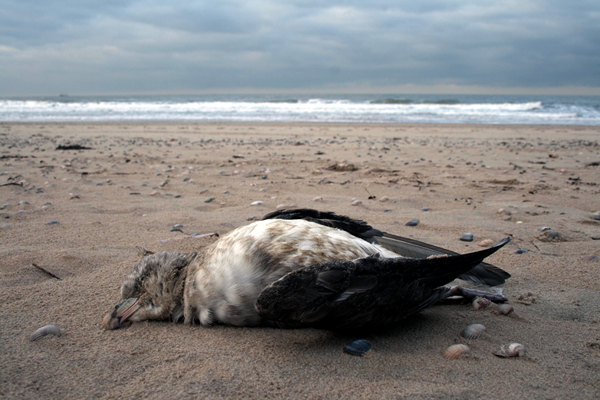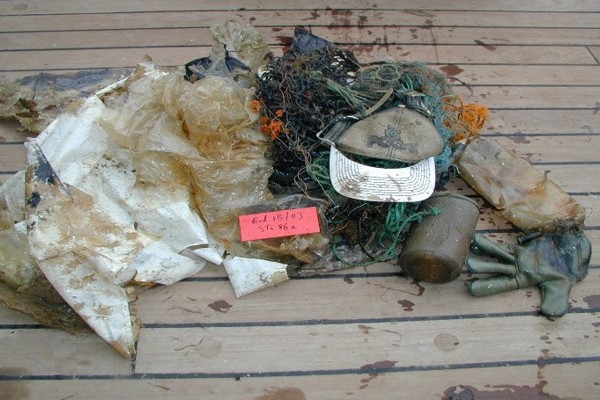Marine litter
The extent to which Good Environmental Status has been achieved
Good Environmental Status (GES) has not yet been achieved for Marine Litter (D10). There have been some positive changes with decreasing trends shown for beach litter in the Celtic Seas and Greater North Sea, and for plastic particles in fulmar in the Greater North Sea, therefore the targets for these indicators have been met. The Seafloor litter assessment, however, has shown an increasing trend in the Greater North Sea and has not been met. Further action is needed, as overall marine litter levels are still high, with a predominance of plastic items.
Progress since previous assessments
Since 2019, further monitoring and assessment work has been carried out including the development of common indicators on seafloor litter and plastic particles in fulmar stomachs. The UK has been working with other countries within OSPAR to develop an indicator to measure microplastics in marine sediment. UK experts have conducted research programmes to establish the extent to which microplastic debris are present and might cause harm to organisms in the marine environment.
The 2019 UKMS assessment showed that trends of beach litter were stable in the Celtic Seas but slightly increasing in the Greater North Sea. There is a real improvement for beach litter, with this latest assessment showing there have been statistically significant decreases in beach litter and plastic abundance observed in the Greater North Sea and in the Celtic Seas. Despite remaining above the OSPAR threshold, the amounts of ingested plastics in fulmar in the Greater North Seas have decreased significantly. These are positive signs considering the continuous increase in plastic production and consumption over the same period. Seafloor litter in the Greater North Sea, however, showed a slight increasing trend in probability that survey hauls would contain litter.
How progress has been assessed
Assessment overview
To determine whether GES has been achieved for marine litter, 3 indicators are assessed against 3 criteria and targets. These indicators look to measure abundance and trends of litter found on beaches, trends in seafloor litter collected during annual ship-based surveys, and trends in litter found in fulmar stomachs. The latter is used as a proxy for floating litter on the sea surface.
The table below sets out the criteria, associated targets and indicators used to assess progress toward meeting GES for D10. For each indicator we set out whether it has been met, not met or partially met, across both UK sub regions.
Table 1. Summary overview of the status assessment for all Marine Litter (D10) indicator assessments
|
Criteria 1 |
Beach litter |
|---|---|
|
2019 Target |
A decrease in the total amount of the most common categories found on surveyed beaches. |
|
Indicator |
Abundance, Composition and Trends of Beach Litter |
|
Greater North Sea |
met |
|
Celtic Seas |
met |
|
Criteria 2 |
Seafloor litter |
|
2019 Target |
A decrease in the number of items of litter on the seabed. |
|
Indicator |
Seafloor litter surveys using benthic trawls |
|
Greater North Sea |
not met |
|
Celtic Seas |
not met |
|
Criteria 3 |
Floating litter |
|
2019 Target |
A downward trend in the number of northern fulmars with more than 0.1g of plastic particles in their stomach. |
|
Indicator |
Floating litter (by proxy, measuring plastic particles in fulmar stomachs). |
|
Greater North Sea |
met |
|
Celtic Seas |
not used |
This GES assessment is based on the Marine Litter OSPAR assessment (OSPAR 2023).
Detailed assessments
Despite indications of reductions in marine litter, litter levels overall remain high. In time this may result in a relative improvement in environmental status, and reduction of ecological impacts and the impacts on ecosystem services. Marine litter in UK waters is periodically monitored through three common indicators: beach litter, plastic particles in the stomachs of fulmars, and seafloor litter.
Beach litter
Beach litter levels remain high, with plastic items predominating The median total counts between 2018 and 2020 are, 205 litter items per 100m of coastline for the Greater North Sea and 278 litter items per 100m of coastline for the Celtic Seas. The litter categories of ‘Single-use Plastics’ (SUP) and ‘Maritime-related plastic items’ (SEA) are targeted by the UK programme of measures. In the Greater North Sea SUP items make up 24% of items, and SEA items make up 25%. In the Celtic Seas SUP items make up 23% of items, and SEA items make up 18% (Lacroix and others, 2022).
Plastic particles in fulmar
Currently in the Greater North Sea 51% of beached North Sea fulmars have more than 0.1 g of plastics in their stomachs, exceeding the OSPAR fulmar threshold value of 10%. This reflects the abundance of floating litter and provides an indication of harm (Kühn and others, 2022).
Seafloor litter
Litter is widespread across the Greater North Sea and Celtic Seas; and fisheries- related items and plastic materials predominate. Looking at spatial maps for the proportions of hauls containing litter items, in the Greater North Sea, there was a north-west (low) to south-east (high) gradient in probability that hauls contain litter. In the Celtic Seas there was a north (low) to south (high) gradient. The Greater North Sea had a higher probability that a haul would contain a litter item (69%) compared with Celtic Seas (45%) (Barry and others, 2022).
Achievement of targets and indicators used to assess progress in 2024
Drivers, activities and pressures affecting the state of the marine environment
Societal needs for food, health and welfare, and stable economies drive demands for materials, industrial processes, trade and movement of goods which all have the potential to contribute litter into the marine environment. Activities associated with the manufacturing, production, packaging, processing, and transportation of fish and the agricultural, industrial, domestic or other commodities required to meet society’s needs all have the potential to produce litter. Agricultural land use, coastal development, ports and shipping, fishing, aquaculture, oil and gas extraction and processing, and tourism and recreation activity can result in litter entering the marine environment on the seafloor, water column and beaches.
Impact of pressure on ecosystem services
Impacts include harm to biota through ingestion and entanglement. Litter affects ecosystem services impacting human welfare through effects on economic sectors such as tourism, fisheries, aquaculture, navigation, and energy; inflicting economic losses on individuals and communities. Specific ecosystem services affected include wild fish and other aquatic biomass and related raw materials; nursery population and habitat maintenance; water quality regulation; coastal protection; pest control; recreation related services; visual amenity services; ecosystem and species appreciation; spiritual, artistic and symbolic services.
Impacts of climate change on pressures and state
Climate change influences atmospheric and ocean circulation and may affect some of the pathways for, and retention of, litter. For example, climate change could lead to changes in river flows which could affect the quantities of marine litter entering the marine environment from rivers, and the subsequent distribution and deposition of litter. Additionally, rising sea levels and an increase in extreme weather is more likely to erode coastal and riparian landfills, moving their contents into rivers and the sea. Therefore, climate change may mobilise historically disposed of domestic and commercial waste to create ‘new’ sources of marine litter. However, the exact effects that climate change will have on marine litter are difficult to predict.
Management actions taken
The actions we are taking to achieve GES for marine litter are set out in the UK Marine Strategy Part 3 2025: Programme of Measures.
The UK is taking action to prevent and divert litter from reaching the marine environment. Marine litter is a transboundary issue, and an international approach is needed to effectively prevent and reduce new and historic marine litter. Waste is a devolved matter, and each administration is implementing measures to make it easier for consumers to reduce and recycle plastic waste, and have introduced bans, restrictions, and charges for several of the single-use plastic items most commonly found on beaches, including plastic carrier bags, straws, stirrers and plastic-stemmed cotton buds.
The administrations of the UK are developing and considering other policy measures, including extended producer responsibility schemes, deposit return schemes, establishing greater consistency in the recycling system, further bans and restrictions, and new charges, like the single use carrier bag charge, for other single use items.
The UK is also working internationally to implement the second OSPAR Regional Action Plan for Marine Litter, which includes actions to tackle land and sea-based sources of marine litter. The UK is leading several actions, including on preventing and reducing marine litter from aquaculture, preventing plastic pellet loss, and stimulating development in the design and management of fishing gear.
Next steps
Evidence challenges
- A lack of quantitative data makes it difficult for us to fully understand the impacts (including harm) marine litter causes on the marine environment. Further research could help us to fill this evidence gap, and there are ongoing workstreams in OSPAR to address this issue.
- There is a need to better understand sources, pathways and transport (including transboundary transport) of marine litter. This work includes improving understanding of riverine litter as a source; there is work ongoing in OSPAR to develop this.
- Further work is needed to understand the effects of climate change on marine litter. There has been some work in the UK Clean and Safe Seas evidence group (CSSEG) to start this.
- The indicator targets for D10 are not considered specific enough across the suite, making it hard to assess progress towards GES. While there have been positive signs of decline in marine litter, a greater decline is needed to reduce the impact on environment; development of more granular targets would better support government to address this. There is one amended target suggested for seafloor litter to make this more measurable (see Technical Detail). This is enabled due to the improved ability to report on trends for this indicator.
Operational objectives
The collective management actions already in place contribute to the wider OSPAR-level and through other international commitments. The UK is calling for an ambitious and effective international treaty to end plastic pollution, including as a member of the High Ambition Coalition to End Plastic Pollution.
Other headline objectives include:
· Establish the feasibility of setting appropriate reduction targets and/ or threshold values for litter on beaches, on the seafloor, on the sea surface and microplastics.
· Develop an indicator for micro-litter in marine sediment. There is work underway to develop an indicator for microplastics in seafloor sediment which may be ready for implementation within the next UKMS assessment cycle.
· Continue to build on the evidence base for ‘harm’ that marine litter causes to ecosystems to inform threshold values and targets.
· Continue current efforts to reduce marine litter.
Technical Detail: Good Environmental Status for the next cycle
Overarching target: The amount of litter and its degradation products on coastlines and in the marine environment is reducing and levels do not pose a significant risk to the environment and marine life.
|
Criteria |
2024-2030 GES targets |
Comment |
Indicators to be used |
|---|---|---|---|
|
Beach litter |
A decrease in the total amount of the most common categories of litter found on surveyed beaches. |
No change |
Existing indicator: Abundance, Composition and Trends of Beach Litter |
|
Seafloor litter |
A decreasing trend in the probability that litter is collected from the seafloor during surveys. |
Changed to reflect improved ability to report on trends for this indicator. |
Existing indicator: Seafloor litter surveys using benthic trawls. |
|
Floating litter |
A downward trend in the number of northern fulmars with more than 0.1g of plastic particles in their stomach. |
No change |
Existing indicator: Floating litter (by proxy, measuring plastic particles in fulmar stomachs).
|
There is work underway to develop an indicator for microplastics in seafloor sediment.
References
Barry, J., Russell, J., van Hal, R., van Loon, W.M.G.M., Norén, K., Kammann, U., Galgani, F., Gago, J., De Witte, B., Gerigny, O., Lopes, C., Pham, C. K., Garcia, S., Sousa, R., Rindorf, A. 2022. Composition and Spatial Distribution of Litter on the Seafloor. In: OSPAR, 2023: The 2023 Quality Status Report for the North-East Atlantic. OSPAR Commission, London. Available at: https://oap.ospar.org/en/ospar-assessments/quality-status-reports/qsr-2023/indicator-assessments/seafloor-litter/
Kühn, S., Van Franeker, J.A. and Van Loon, W. 2022. Plastic Particles in Fulmar Stomachs in the North Sea. In: OSPAR, 2023: The 2023 Quality Status Report for the Northeast Atlantic. OSPAR Commission, London. Available at: https://oap.ospar.org/en/ospar-assessments/quality-status-reports/qsr-2023/indicator-assessments/plastic-in-fulmar/
Lacroix, C., André, S., and van Loon, W. 2022. Abundance, Composition and Trends of Beach Litter. In: OSPAR, 2023: The 2023 Quality Status Report for the North-East Atlantic. OSPAR Commission, London. Available at: https://oap.ospar.org/en/ospar-assessments/quality-status-reports/qsr-2023/indicator-assessments/beach-litter/
OSPAR, 2023. Marine Litter Thematic Assessment. In: OSPAR, 2023: Quality Status Report 2023. OSPAR Commission, London. Available at: Marine Litter Thematic Assessment
Contributors
Josie Russell, Hannah Masani, Isobel Shears, Manuel Nicolaus, Stacey Clarke.



